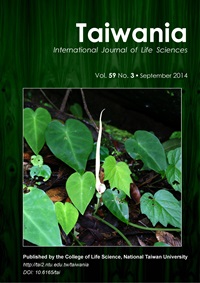Research Paper
Asexual Bulbil Development and Diversification of Reproductive Strategy between Remusatia vivipara and Remusatia pumila (Araceae)
Chi-Tung Huang and Chang-Fu Hsieh
Published on: 15 September 2014
Page: 220 - 230
DOI: 10.6165/tai.2014.59.220
Abstract
Remusatia vivipara and Remusatia pumila can produce both sexual flowers and asexual bulbils. However, R. vivipara seldom set seeds, whereas R. pumila have regular seed set. Our aim was to understand the asexual mode of bulbil development and the reasons for sexual failure in R. vivipara. Asexual bulbil development was observed by scanning electron and light microscopy. Pollen viability and germination rate were counted for at least 200 pollen grains in triplicate for each inflorescence. Chromosome counting was performed to confirm R. vivipara as triploid species. The bulbiliferous shoots of both R. vivipara and R. pumila initiate from the upper portions of tubers. As they elongate upward, bulbil clusters generates in each node of the shoot. Bulbils develop several hooked scales on top simultaneously, which facilitate dispersal because they can easily attach to the animal’s fur. Although R. vivipara produces showy flowers in spring, their pollen grains were inviable and unable to germinate in vitro in sucrose solution, when compared with R. pumila. These two bulbiliferous species have diversified their reproductive strategies, with respect to R. vivipara being able to reproduce completely asexually and R. pumila being able to reproduce both sexually and asexually.
Keyword: Araceae, hooked scale, pollen viability, pollen germination, Remusatia vivipara, Remusatia pumila.


